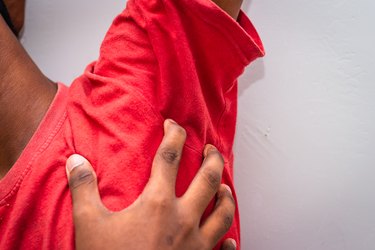
We've probably all experienced itchy armpits after a slipshod or too speedy shaving session (razor burn, anyone?). But what if you haven't trimmed your underarms in weeks (we won't judge — body hair preference is your prerogative), and you still have an intense itch?
Let's face it: Annoyingly itchy armpits can be, well, the pits. But should you be alarmed by this armpit issue? A prolonged prickly feeling in your pits can be caused by a range of things, from minor health issues to more serious medical conditions.
Video of the Day
Video of the Day
Here, dermatologists dish on the top reasons for unrelentingly itchy underarms, plus ways to find relief.
1. You Have Contact Dermatitis
If you have incessantly itchy armpits, you may be dealing with contact dermatitis, a rash that happens when your skin encounters an irritant or allergen.
"An irritant contact reaction occurs due to something harsh that is aggravating the skin," says Y. Claire Chang, MD, a board-certified dermatologist at Union Square Laser Dermatology. "Common triggers are alcohols, soaps, surfactants, dyes, detergents, resins and even sweat," she says.
Alternatively, "an allergic contact reaction occurs after contact with a substance that you are allergic to," Dr. Chang says. Common culprits include fragrances, preservatives, botanicals, dyes and soaps.
It's worth noting that deodorant products often contain alcohol to control bacteria that causes armpit odor. So it's possible that your deodorant is the culprit.
Other symptoms of contact dermatitis may involve, per Dr. Chang:
- Redness
- Flaking
- Swelling
- Burning or stinging
- Blisters
While anyone can experience this skin issue, "those with eczema, aka atopic dermatitis, may be at higher risk of contact dermatitis," Dr. Chang says.
Fix it: “The most important tip in treatment is pretty common sense — make sure you avoid the causative trigger,” Dr. Chang says. To do this, you must first identify the root of the rash. Keep a running tab of the products that you’re using and take note when the rash relapses.
“Your doctor may do patch testing on your skin to identify possible allergens [as well],” Dr. Chang says.
In the meantime, you should also stop applying anything to your armpit area for a couple of days and use a gentle cleanser to wash the region once daily, says board-certified dermatologist Lauren Ploch, MD, MEd.
“Topical steroids, like hydrocortisone or prescription steroids, may be used to improve the [itching] rash,” Dr. Chang says. Still, these anti-itch creams should be applied sparingly, Dr. Ploch adds.
If your case of contact dermatitis is severe, your doctor may also prescribe oral steroids, Dr. Chang says.
Additionally, Dr. Ploch recommends switching to a "free and clear" or "free and gentle" detergent, ditching dryer sheets and avoiding fabric softener altogether since they can all complicate contact dermatitis.
2. You Have Intertrigo
Your underarm itch could be instigated by intertrigo, an inflammatory rash that is caused by friction, excess moisture and heat along the skin folds, Dr. Chang says.
When these areas of skin rub against each, it leads to irritation. And warm, damp environments only worsen the inflammation, Dr. Chang says. That's because humid places are ideal for the overgrowth of bacteria and/or fungi, which can ramp up the rash, she explains.
In addition to itchiness, intertrigo also presents with red or pink and scaly or dry skin patches, "but the skin can also be moist and macerated, leading to discomfort and burning pain," Dr. Ploch says.
"Sometimes the skin may become cracked, oozy or crusty and may be associated with a bad smell," Dr. Chang adds.
Since intertrigo occurs along skin folds, it can also impact areas such as the groin, under the breasts, between abdominal folds and the buttocks, Dr. Chang says.
And some people may have a greater risk of developing this rash. "Risk factors for intertrigo include immunosuppression, obesity, diabetes, exposure to high heat and humidity and use of a splint, brace or other occluding factors," Dr. Chang says.
Fix it: “To prevent and treat intertrigo, it is important to keep areas under the skin folds clean and dry, especially after sweating or in high humidity environments,” Dr. Chang says.
Dr. Ploch recommends washing the armpit area with a gentle cleanser daily, making sure to dry it well before applying an antiperspirant. Using an antiperspirant is especially key for those who tend to perspire profusely since excessive sweating can worsen symptoms of intertrigo, Dr. Chang says.
Dr. Ploch also suggests trying over-the-counter anti-fungal or anti-yeast powders to minimize microbial overgrowth and keep the armpit area dry, particularly if you live in a warm, humid climate.
Over-the-counter barrier creams — including zinc oxide or petrolatum — can also be useful in preventing chafing and friction while wearing breathable, loose-fitting clothing and non-irritating fabrics like cotton can also help hinder intertrigo, Dr. Chang says.
And if your intertrigo is instigated by health conditions like obesity or diabetes, managing these medical issues will be important to reduce recurrences of the rash, Dr. Chang says. “Severe cases [will] require [an] evaluation by a dermatologist and might require a prescription oral medication,” Dr. Ploch adds.
3. You Have Eczema
Eczema in your armpits? Yep, it can happen.
"Atopic dermatitis, commonly known as eczema, is [an inflammatory skin condition] associated with a red, flaky and very itchy rash, often in the body folds, including armpits, flexural elbows or back of the knees," Dr. Chang says.
On top of the tickly feeling, your armpit "area may become dry or cracked and may bleed if scratched excessively," Dr. Chang says.
Eczema can also be exacerbated when you encounter an allergen, Dr. Ploch says. Which is why atopic dermatitis can at times appear indistinguishable from contact dermatitis.
So, how can you tell the difference? "Contact dermatitis only affects areas that are in contact with an allergen while atopic dermatitis is usually more diffuse [meaning it can affect all areas of your skin]," Dr. Ploch explains.
Though eczema can strike at any age, it's most common in young children, and flares are most frequent in people with dry skin or those who live in low humidity environments, Dr. Chang says.
Fix it: “Atopic dermatitis is a medical condition that needs evaluation by a dermatologist who can discuss the most appropriate treatment for an individual,” Dr. Ploch says.
Often, your doctor will prescribe “topical steroids [which] can be used to relieve itchiness in eczema,” Dr. Chang says. What’s more, “it’s important to keep the skin hydrated with frequent emollient use,” she says. By decreasing the dryness, you reduce your risk of recurrences.
4. You Have a Heat Rash
If your armpits tend to become tender and itchy on hot days or during activities that raise your body temperature, heat rash may be to blame.
"A heat rash can occur due to excess heat and sweat obstructing the sweat glands and ducts, which results in inflammation," Dr. Chang says.
And people usually develop this itchy irritation in skin folds (like armpits) or when clothing rubs against the skin, according to the Mayo Clinic.
In addition to an annoying itch, heat rash may also result in red, prickly and bumpy skin (think: small, uniform bumps), Dr. Chang says. But it can also cause symptoms like small blisters or deep, inflamed lumps depending on severity, per the Mayo Clinic.
Fix it: It’s no surprise that the risk of having heat rash ramps up in hot, humid summer months, so to keep it at bay, the best strategy is to keep your skin cool and dry.
“Wearing loose-fitting, cotton clothing can help prevent sweat gland obstruction and minimize friction,” Dr. Chang says. Other ways to prevent a prickly heat rash include, per the Mayo Clinic:
- In hot weather, limit physical activity, stay in the shade or in an air-conditioned building and use a fan to circulate the air
- Keep your sleeping area cool and well ventilated
- Avoid creams and ointments that can block pores
- Avoid drugs that cause sweating, such as clonidine, beta blockers and opioids
But if you do get hit by heat rash, don’t fret. Fortunately, the itchy side effects are short-lived. “Heat rash usually resolves within two to three days,” Dr. Ploch says. To speed up the healing process, Dr. Ploch recommends washing the area with a gentle cleanser and applying an over-the-counter hydrocortisone cream. Avoid ointments, which are occlusive and can worsen a rash.
You can also get rapid relief by “taking a cool shower or using a fan with cool air to keep your skin cool and dry,” Dr. Chang adds.
5. You Have Inverse Psoriasis
"Inverse psoriasis [is an immune-mediated disease that] can cause an itchy, red rash in the skin folds, including the armpits," Dr. Chang says.
This itchy skin issue is initiated by an overreactive immune response that creates inflammation and triggers the overproduction of new skin cells, according to the Cleveland Clinic.
Individuals with inverse psoriasis sprout new skin cells every three to four days (for reference, healthy people grow new ones every month or so), per the Cleveland Clinic. And this exponential increase in skin cells leads to issues like itchiness.
So, what's the difference between psoriasis and inverse psoriasis? "Though typical psoriasis lesions are very thick, white and scaly, inverse psoriasis is often red, non-scaly, sore and itchy," Dr. Chang says.
Also, an inverse psoriasis-related rash appears shinier than a patch of psoriasis plaques, per the Cleveland Clinic. Which is probably because it propagates in parts of the body that tend to be moist (think: not just your armpits, but your belly button, the area below your breasts and your groin too).
Fix it: Because they present similar symptoms, “inverse psoriasis is often mis-diagnosed as contact reactions or intertrigo,” Dr. Chang says. See a trusted, board-certified dermatologist who can properly assess you and correctly identify your condition. Recommended treatments may include prescription topical steroids or systemic therapies like biologic injections.
6. You Have a Lymphoma
A lymphoma — or cancer of the lymphatic system — can also lead to itchy underarms.
"Lymphomas may cause a chronic itch in patients as part of a paraneoplastic syndrome [an abnormal response by your immune system in reaction to a cancerous tumor]," Dr. Chang says.
This appears to happen when antibodies or white blood cells that fight cancer inadvertently attack normal nerve cells, according to the National Institute of Neurological Disorders and Stroke (NINDS). And in this case, it can affect nerves in the skin and trigger itchiness.
"Paraneoplastic itch may or may not present with associated skin changes, including eczema-like or ichthyosiform skin [excessive scaliness] or signs of scratching like excoriations and dyspigmentation," Dr. Chang says. On the other hand, some people simply experience an insistent itch sans other skin symptoms.
Along with itchy skin, other signs of lymphoma may include, per the Mayo Clinic:
- Painless swelling of lymph nodes in your neck, armpits or groin
- Persistent fatigue
- Fever
- Night sweats
- Shortness of breath
- Unexplained weight loss
"Skin lymphomas like T-cell or B-cell lymphoma [cancers that start in white blood cells that are located in the skin] can also produce rashes that are associated with itch," Dr. Chang says. "The rashes can vary in appearance, ranging from psoriasis-like rashes to generalized redness," she says.
Fix it: Catching cancer early is essential. If you’re experiencing any of the above symptoms, see your doctor immediately, who can properly diagnose you and plan a proper course of treatment.
7. You Have Inflammatory Breast Cancer
Unfortunately, lymphoma isn't the only malignant medical condition linked to itchy underarms. "Inflammatory breast cancer is a rare form of breast cancer that can be associated with itchiness in the breast and surrounding skin, including the armpits," Dr. Chang says.
As well as itchiness, other signs of inflammatory breast cancer include, per Dr. Chang:
- Breast swelling
- Redness
- Thickening or pitting of the skin over the affected breast
- Inverted nipple
- Swelling in the surrounding lymph nodes
Fix it: “If any rash results in changes to the nipple or areola, I recommend seeing a dermatologist as soon as possible,” Dr. Ploch says. “This [disease] must be diagnosed via skin biopsy by a dermatologist,” she says.
Dr. Chang notes there are a few other — less common — causes of itchy inflmmatory armpit rashes:
- Rashes resulting from medication side effects
- Erythrasma (a skin infection caused by bacteria)
- Hailey-Hailey Disease (a rare genetic skin disorder that causes blistering in the neck, armpits, skin folds and genitals)
When Should You See a Doctor for Itchy Armpits?
"If itchy armpits do not go away with simple at-home measures or get worse, you should see your doctor to get an evaluation [and rule out more serious causes]," Dr. Chang says.
"A board-certified dermatologist may be able to better evaluate and diagnose the condition using visual inspection, biopsy or patch testing," she says.
Once you have a proper diagnosis, your doctor will be able to prescribe an individualized treatment plan and help put an end to your itchy pits.
Is this an emergency? If you are experiencing serious medical symptoms, please see the National Library of Medicine’s list of signs you need emergency medical attention or call 911.


